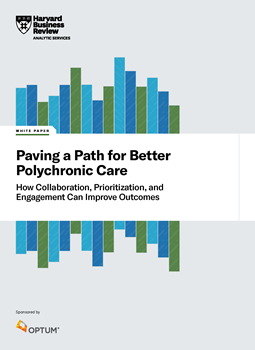Paving a Path for Better Polychronic Care
How Collaboration, Prioritization, and Engagement Can Improve Outcomes
The health care system was designed to treat transactional episodes of care. Now it's under stress from more complex patient needs and the rise of polychronic cases — or people with more than one chronic disease. Polychronic patients are diverse in background and complexity of needs. They require extra attention to help them understand conditions, comply with care plans and navigate complicated systems.
This white paper was developed through research by Harvard Business Review Analytic Services in association with Optum. It examines:
- Polychronic patients and the challenges they face
- How health leaders are working to better understand the polychronic population
- Opportunities for and the limitations of data sharing and interoperability
- Ways in which collaboration can both improve the quality of care and prevent chronic disease
Better serving polychronic patients means considering social determinants and health equity. It means making real efforts to improve patient engagement and prioritizing care with the right information. Find out how you can enable fundamental changes in the health care system. Reinvent processes, priorities and systems to treat the whole person and help change the trajectory of health care costs

Sponsored by:
-4f5d90854cd4b0efffdabb0b162ee8110b3f33ce.jpg?v=08132020171811)
DOWNLOAD NOW FOR FREE!
By downloading this resource, I agree to sign up to receive newsletters and special offers from HealthLeaders and the sponsor. I understand that I can opt-out at any time. Privacy policy.
